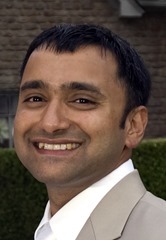 Darshan Rane and I met each other at a presentation on Design in Business by Thomas Lockwood up at the University of Utah a few weeks ago. A couple of days after crossing paths, I sat down with one of my professors, David Morgan, to discuss my senior thesis project where I am designing a prosthetic for a trans-tibial amputee. David recommended that I reach out to a designer he knows in Salt Lake who works on prosthetics, “His name is Darshan Rane.” I laughed, “It’s a small world in Industrial Design.”
Darshan Rane and I met each other at a presentation on Design in Business by Thomas Lockwood up at the University of Utah a few weeks ago. A couple of days after crossing paths, I sat down with one of my professors, David Morgan, to discuss my senior thesis project where I am designing a prosthetic for a trans-tibial amputee. David recommended that I reach out to a designer he knows in Salt Lake who works on prosthetics, “His name is Darshan Rane.” I laughed, “It’s a small world in Industrial Design.”
Darshan Rane grew up in India. He received his undergrad in engineering in Bombay, India before coming to the United States to get a Master of Fine Arts in Industrial design from Rochester Institute of Technology(RIT). David Morgan was a professor at RIT at the time and oversaw Darshan’s graduate thesis project. After finishing his graduate program, Darshan worked for Century Martial Arts for a few years while doing some freelance work on the side with a friend.
“I have always been interested in ergonomics and the way products connect to people.”
After a few years of producing top of the line martial arts gloves and gear, Darshan applied to a position at Ottobock in Salt Lake City. “I have always been interested in ergonomics and the way products connect to people. With my past designing gloves and and pads for martial arts, I had experience securing products to the body while considering variables such as sweat. This really qualified me for the position at Ottobock where I would be working on orthotics and prosthetics. I also was excited to move to Utah because I am an avid rock climber.”
Ottobock is the worlds leading producer of Prosthetic devices. It is an international company centered in Germany. Darshan is the only Industrial Designer employed by Ottobock in the United States. There are three more designers in Germany. “Ottobock is more of an engineering company. We don’t have traditional design projects like you have in school. The other designers and I work with others who don’t always see the value of the industrial design perspective. The four of us work together helping others to understand the insight we have to offer and to making design a bigger part of Ottobock’s company culture. In a company where Industrial Design isn’t fully utilized, you can either leave it or change it. The four of us decided we wanted to change it.”
“What problem am I solving? Who is the end user?”
When approaching a particular project at Ottobock, Darshan focuses on the following questions: Who is this for? What is the target level of activity, e.g. casual walking or athletics? What problem am I solving? What makes this solution unique? “Most of patients who are recent amputees are looking to blend into the background with their prosthetic. There are exceptions, like the younger crowd in the United States who will wear their prosthetics proudly with shorts, but in Europe the users are much more discrete about it.”
In my conversation with Darshan, his passion for helping people with product solutions was clear. “I enjoy working at Ottobock because of the dramatic difference our work has on patients’ lives.”